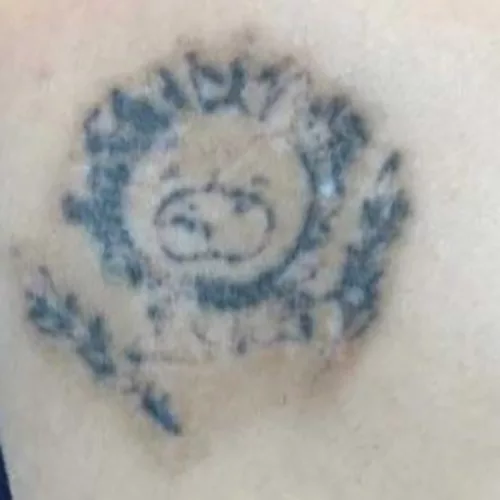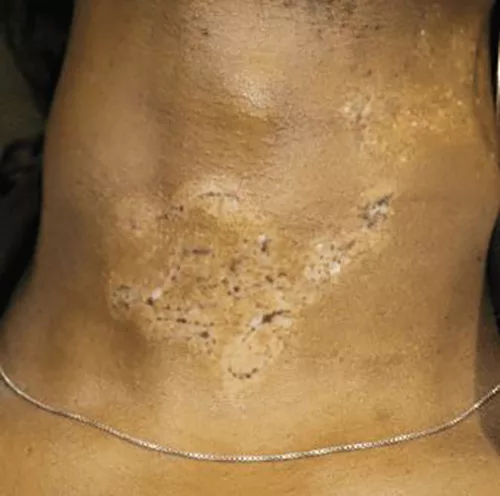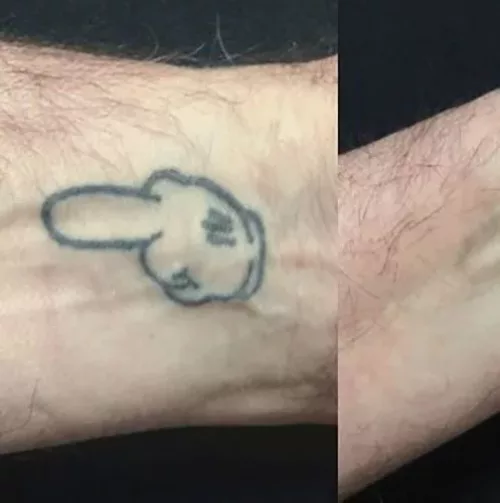Hyperpigmentation and Hypopigmentation
At Rebel Inks Tattoos, Tattoo Removal and Body Piercings Parlor, we recognize that laser tattoo removal is a journey towards embracing a fresh start. As industry leaders in safe and advanced tattoo removal services, we understand the importance of addressing potential skin pigmentation changes during the process. In this comprehensive guide, we’ll shed light on hyperpigmentation and hypopigmentation, how they relate to laser tattoo removal, and how our skilled technicians prioritize your skin’s well-being throughout the procedure.
Hyperpigmentation and hypopigmentation are two common skin conditions that involve changes in the skin’s coloration. They can occur due to various reasons and may have different underlying causes and treatment approaches. Let’s explore each condition in detail:
Hyperpigmentation and Hypopigmentation
What is Hyperpigmentation?
Hyperpigmentation is a common skin condition that occurs when certain areas of the skin become darker than the surrounding skin. During laser tattoo removal, the intense pulses of light target and break down the tattoo ink, which may stimulate the production of melanin in the treated area. This melanin response can lead to temporary hyperpigmentation, causing the skin to appear darker than usual. While this side effect is generally temporary, it may take several months for the skin to return to its normal pigmentation. Several factors can contribute to the development of hyperpigmentation during tattoo removal:
- Skin Type: People with darker skin tones are more prone to hyperpigmentation because their skin contains more melanin, which responds more aggressively to the laser.
- Sun Exposure: Exposure to the sun before or after the laser tattoo removal treatment can increase the risk of hyperpigmentation. The UV radiation can stimulate melanin production, leading to dark spots.
- Inflammatory Response: The laser treatment causes a controlled injury to the skin, triggering an inflammatory response. In some cases, this inflammation can stimulate melanocytes to produce more melanin.
- Laser Settings: If the laser intensity or wavelength used in the tattoo removal is not properly calibrated to the individual’s skin type and tattoo color, it can increase the risk of hyperpigmentation..

How To Minimize Hyperpigmentation Risks:
Preventing hyperpigmentation after laser tattoo removal is crucial for achieving a successful outcome and maintaining an even skin tone in the treated area. While it’s not always possible to completely eliminate the risk of hyperpigmentation, there are several steps you can take to minimize its occurrence. Here are some tips to help prevent hyperpigmentation after laser tattoo removal:
- Choose a Qualified and Experienced Practitioner: Selecting a reputable and experienced practitioner who specializes in laser tattoo removal is essential. An experienced professional will assess your skin type, tattoo color, and medical history to determine the most appropriate laser settings for your specific case.
- Sun Avoidance: Before and after the laser tattoo removal sessions, it’s crucial to avoid sun exposure to the treated area. UV radiation can stimulate melanin production and increase the risk of post-treatment hyperpigmentation. If you must go outside, use protective clothing and sunscreen with a high SPF (at least 30) to shield the treated area from the sun.
- Follow Aftercare Instructions: Adhere to the aftercare instructions provided by your practitioner diligently. This may include avoiding certain skincare products, hot showers, saunas, or activities that can irritate the treated skin. Proper aftercare can contribute to better healing and reduce the risk of complications.
- Topical Treatments: Your practitioner may recommend specific topical creams or ointments to apply to the treated area to promote healing and reduce the risk of hyperpigmentation.
- Gradual Tattoo Removal: In some cases, a more gradual tattoo removal approach may be advised. By spacing out treatment sessions and using lower laser energies, the risk of hyperpigmentation may be reduced.
- Skin Type Consideration: Individuals with darker skin tones (Fitzpatrick skin types IV-VI) are more prone to hyperpigmentation. If you have a darker complexion, discuss the potential risks and benefits of laser tattoo removal with your practitioner.
- Monitor Progress: Regularly communicate with your practitioner and monitor the progress of your tattoo removal. If you notice any concerning changes, such as increased hyperpigmentation or other side effects, inform your practitioner immediately.
- Avoid Picking or Scratching: Refrain from picking, scratching, or picking at scabs or blisters that may form after the treatment. Doing so can cause further irritation and potentially lead to pigment changes.
- Patience: Laser tattoo removal is a gradual process, and multiple sessions are often required for complete tattoo clearance. Be patient and follow the recommended treatment plan to achieve the best results.
How To Treat Hyperpigmentation
Hyperpigmentation treatment options aim to reduce the appearance of dark spots or patches on the skin caused by excess melanin production. The choice of treatment depends on the type, cause, and severity of hyperpigmentation. Here are some common treatment options:
-
Topical Creams or Serums:
Hydroquinone: A skin-lightening agent that inhibits melanin production. It is commonly used for treating various types of hyperpigmentation.
Retinoids: Derived from vitamin A, retinoids can help fade dark spots and promote skin cell turnover, leading to a more even complexion.
Vitamin C: An antioxidant that can help brighten the skin and reduce hyperpigmentation.
- Chemical Peels: Chemical peels involve applying a chemical solution to the skin, which exfoliates the top layer, leading to skin rejuvenation and a reduction in hyperpigmentation.
- Microdermabrasion: Microdermabrasion uses a device to exfoliate the outer layer of the skin, promoting new skin growth and helping to fade dark spots.
- Laser Therapy: Laser treatments, such as fractional laser or Q-switched lasers, can target melanin in the skin, breaking down excess pigment and promoting skin rejuvenation.
- Intense Pulsed Light (IPL): IPL uses broad-spectrum light to target and break down areas of hyperpigmentation, encouraging the skin to heal and reduce dark spots.
- Cryotherapy: Cryotherapy involves freezing the dark spots with liquid nitrogen to destroy the excess pigment cells.
- Chemical Agents: Kojic acid, azelaic acid, and licorice extract are natural skin-lightening agents that can help reduce hyperpigmentation.
- Sunscreen: Regularly using a broad-spectrum sunscreen with a high SPF is crucial in preventing further darkening of hyperpigmented areas. Sun protection helps prevent UV-induced melanin production.
- Combination Therapy: In some cases, a combination of treatments may be recommended by dermatologists to address different aspects of hyperpigmentation and achieve better results.
What is Hypopigmentation?
Hypopigmentation is another potential side effect of laser tattoo removal, but less common than hyperpigmentation. It occurs when the laser energy inadvertently affects the melanocytes responsible for producing skin pigment, resulting in a lightening of the treated area. Like hyperpigmentation, hypopigmentation is typically temporary, and the skin’s pigmentation may gradually return to normal over time.
How To Minimize Hypopigmentation Risks
Preventing hypopigmentation after laser tattoo removal is essential to ensure a successful and satisfactory outcome. While it’s not always possible to completely eliminate the risk of hypopigmentation, there are several steps you can take to minimize the chances of this side effect. Here are some tips to help prevent hypopigmentation after laser tattoo removal:
- Choose a Qualified and Experienced Practitioner: Make sure to select a reputable and experienced practitioner who is skilled in laser tattoo removal. A knowledgeable professional will assess your skin type, tattoo color, and medical history to determine the most appropriate laser settings for your specific case.
- Consider Skin Type and Tattoo Color: Different skin types respond differently to laser treatments. Darker skin types are more prone to hypopigmentation, so it’s essential to discuss the potential risks and benefits with your practitioner. The color of the tattoo ink can also influence the laser settings used during the procedure.
- Sun Avoidance: Before and after the laser tattoo removal sessions, it’s crucial to avoid sun exposure to the treated area. UV radiation can stimulate melanin production and increase the risk of post-treatment hyperpigmentation or hypopigmentation.
Sunscreen: If you need to go outside, make sure to apply a broad-spectrum sunscreen with a high SPF (at least 30) to the treated area. Reapply the sunscreen every two hours, especially if you are exposed to the sun for an extended period. - Follow Aftercare Instructions: Adhere to the aftercare instructions provided by your practitioner diligently. This may include avoiding certain skincare products, hot showers, saunas, or activities that can irritate the treated skin. Proper aftercare can contribute to better healing and reduce the risk of complications.
- Avoid Picking or Scratching: Refrain from picking, scratching, or picking at scabs or blisters that may form after the treatment. Doing so can cause further irritation and potentially lead to pigment changes.
- Moisturize: Keep the treated area well-moisturized with a gentle, non-irritating moisturizer recommended by your practitioner. Proper hydration can aid in the healing process.
- Follow Treatment Plan: Stick to the recommended treatment schedule and avoid skipping sessions unless advised by your practitioner. Completing the full treatment plan is crucial to achieve the best results and reduce the risk of side effects.
- Monitor Progress: Regularly communicate with your practitioner and monitor the progress of your tattoo removal. If you notice any concerning changes, such as increased hypopigmentation or other side effects, inform your practitioner immediately.

How To Treat Hypopigmentation
Hypopigmentation, the condition characterized by a loss or reduction of skin color, can be challenging to treat, especially if the underlying cause is not reversible. However, several treatment options are available that may help improve the appearance of hypopigmented areas. It’s important to note that the effectiveness of these treatments can vary based on the cause and extent of hypopigmentation. Here are some common treatment options:
- Topical Corticosteroids: In some cases, topical corticosteroid creams or ointments may be prescribed to help promote repigmentation. These medications can reduce inflammation and potentially stimulate melanocytes to produce more melanin.
- Topical Immunomodulators: Certain topical immunomodulators, such as tacrolimus or pimecrolimus, may be used to treat hypopigmentation caused by inflammatory conditions like vitiligo.
- Phototherapy: Phototherapy involves exposing the hypopigmented skin to ultraviolet (UV) light. Narrowband UVB phototherapy is a common approach used to stimulate melanocytes and encourage repigmentation in cases of vitiligo or other forms of hypopigmentation.
- Psoralen Plus Ultraviolet A (PUVA) Therapy: PUVA therapy combines the use of psoralen, a light-sensitizing medication, with UVA light exposure. It is used primarily for vitiligo treatment to stimulate melanin production.
- Excimer Laser: The excimer laser emits UVB light and is used for targeted treatment of hypopigmented areas, particularly in vitiligo.
- Microneedling: Microneedling, also known as collagen induction therapy, involves using tiny needles to create controlled micro-injuries in the skin, which can stimulate melanocyte activity and promote repigmentation.
- Depigmentation (for extensive vitiligo): In cases of widespread vitiligo where depigmentation is preferred, topical creams containing monobenzone or other depigmenting agents may be used to lighten the remaining skin color to match the depigmented areas.
- Tattooing: In some cases, medical tattooing or micropigmentation may be an option to match the hypopigmented areas’ color with the surrounding skin.
- Camouflage Makeup: The use of specialized camouflage makeup can help conceal hypopigmented areas and provide a more even skin tone temporarily.
OUR LOCATION
Areas We Serve
NAIROBI
KIAMBU
KAJIADO
MACHAKOS


